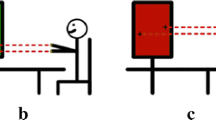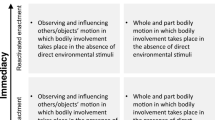Abstract
This article concerns the purpose, function, and mechanisms of students’ rhythmic behaviors as they solve embodied-interaction problems, specifically problems that require assimilating quantitative information structures embedded into the environment. Analyzing multimodal data of one student tackling a bimanual interaction design for proportion, we observed the (1) evolution of coordinated movements with stable temporal–spatial qualities; (2) breakdown of this proto-rhythmic form when it failed to generalize across the problem space; (3) utilization of available resources to obtain greater specificity by way of measuring spatial spans of movements; (4) determination of an arithmetic pattern governing the sequence of spatial spans; and (5) creation of a meta-rhythmic form that reconciles continuous movement with the arithmetic pattern. The latter reconciliation selectively retired, modified, and recombined features of her previous form. Rhythmic enactment, even where it is not functionally imperative, appears to constitute a tacit adaptation goal. Its breakdown reveals latent phenomenal properties of the environment, creating opportunities for quantitative reasoning, ultimately supporting the learning of curricular content.




Similar content being viewed by others

Notes
The interviewer’s question could have been interpreted as relating to a global enactment of continuous movement, yet K responded to the question by initiating local subtasks.
References
Abrahamson, D. (2004). Embodied spatial articulation: A gesture perspective on student negotiation between kinesthetic schemas and epistemic forms in learning mathematics. In D. E. McDougall & J. A. Ross (Eds.), Proceedings of the twenty-sixth annual meeting of the North American Chapter of the International Group for the Psychology of Mathematics Education (Vol. 2, pp. 791–797). Toronto, Ontario: Preney.
Abrahamson, D. (2009). Embodied design: Constructing means for constructing meaning. Educational Studies in Mathematics, 70(1), 27–47.
Abrahamson, D. (2014). Building educational activities for understanding: An elaboration on the embodied-design framework and its epistemic grounds. International Journal of Child-Computer Interaction, 2(1), 1–16.
Abrahamson, D., & Lindgren, R. (2014). Embodiment and embodied design. In R. K. Sawyer (Ed.), The Cambridge handbook of the learning sciences (2nd ed., pp. 358–376). Cambridge: Cambridge University Press.
Abrahamson, D., Lee, R. G., Negrete, A. G., & Gutiérrez, J. F. (2014). Coordinating visualizations of polysemous action: Values added for grounding proportion. ZDM Mathematics Education, 46(1), 79–93.
Abrahamson, D., & Trninic, D. (2015). Bringing forth mathematical concepts: Signifying sensorimotor enactment in fields of promoted action. ZDM Mathematics Education, 47(2), 295–306.
Abrahamson, D., & Wilensky, U. (2007). Learning axes and bridging tools in a technology-based design for statistics. International Journal of Computers for Mathematical Learning, 12(1), 23–55.
Bamberger, J., & diSessa, A. (2003). Music as embodied mathematics: A study of a mutually informing affinity. International Journal of Computers for Mathematical Learning, 8(2), 123–160.
Bautista, A., & Roth, W.-M. (2012). The incarnate rhythm of geometrical knowing. The Journal of Mathematical Behavior, 31(1), 91–104.
Goldin, G. A. (2000). A scientific perspective on structured, task-based interviews in mathematics education research. In A. E. Kelly & R. A. Lesh (Eds.), Handbook of research design in mathematics and science education (pp. 517–545). Mahwah, NJ: Lawrence Erlbaum Associates.
Kelso, J. A., & Engstrom, D. A. (2006). The complementary nature. Cambridge, MA: MIT Press.
Kelton, M. L., & Ma, J. Y. (2018). Reconfiguring mathematical settings and activity through multi-party, whole-body collaboration. Educational Studies in Mathematics, 98(2), 177–196.
Koschmann, T., Kuuti, K., & Hickman, L. (1998). The concept of breakdown in Heidegger, Leont’ev, and Dewey and its implications for education. Mind, Culture, and Activity, 5(1), 25–41.
Leung, A., Baccaglini-Frank, A., & Mariotti, M. A. (2013). Discernment of invariants in dynamic geometry environments. Educational Studies in Mathematics, 84(3), 439–460.
Mason, J. (1989). Mathematical abstraction as the result of a delicate shift of attention. For the Learning of Mathematics, 9(2), 2–8.
Mason, J. (2002). Researching your own practice: The discipline of noticing. London: Routledge Falmer.
Mason, J. (2010). Attention and intention in learning about teaching through teaching. In R. Leikin & R. Zazkis (Eds.), Learning through teaching mathematics: Development of teachers’ knowledge and expertise in practice (pp. 23–47). Dordrecht: Springer.
Nemirovsky, R., & Ferrara, F. (2009). Mathematical imagination and embodied cognition. In L. Radford, L. Edwards, & F. Arzarello (Eds.), Gestures and multimodality in the construction of mathematical meaning [special issue]. Educational Studies in Mathematics, 70(2), 159-174.
Nemirovsky, R., Kelton, M. L., & Rhodehamel, B. (2013). Playing mathematical instruments: Emerging perceptuomotor integration with an interactive mathematics exhibit. Journal for Research in Mathematics Education, 44(2), 372–415.
Newman, D., Griffin, P., & Cole, M. (1989). The construction zone: Working for cognitive change in school. New York, NY: Cambridge University Press.
Piaget, J., Inhelder, B., & Szeminska, A. (1960). The child’s conception of geometry (E.A. Lunzer, Trans.). New York: Basic.
Radford, L. (2009). Why do gestures matter? Sensuous cognition and the palpability of mathematical meanings. In L. Radford, L. Edwards, & F. Arzarello (Eds.), Gestures and multimodality in the construction of mathematical meaning [special issue]. Educational Studies in Mathematics, 70(2), 111-126.
Radford, L. (2015). Rhythm as an integral part of mathematical thinking. In M. Bockarova, M. Danesi, D. Martinovic, & R. Núñez (Eds.), Mind in mathematics: Essays on mathematical cognition and mathematical method (pp. 68–85). Munich: LINCOM GmbH.
Radford, L., Arzarello, F., Edwards, L., & Sabena, C. (2017). The multimodal material mind: Embodiment in mathematics education. In J. Cai (Ed.), First compendium for research in mathematics education (pp. 700–721). Reston, VA: National Council of Teachers of Mathematics.
Reinholz, D., Trninic, D., Howison, M., & Abrahamson, D. (2010). It’s not easy being green: Embodied artifacts and the guided emergence of mathematical meaning. In P. Brosnan, D. Erchick, & L. Flevares (Eds.), Proceedings of the 32 nd annual meeting of the North American Chapter of the International Group for the Psychology of Mathematics Education (PME-NA 32) (Vol. VI, Ch. 18: “Technology,” pp. 1488–1496). Columbus, OH: PME-NA.
Richmond, L. L., & Zacks, J. M. (2017). Constructing experience: Event models from perception to action. Trends in Cognitive Sciences, 21(12), 962–980.
Rosen, D. M., Palatnik, A., & Abrahamson, D. (2018). A better story: An embodied-design argument for generic manipulatives. In N. Calder, N. Sinclair, & K. Larkin (Eds.), Using mobile technologies in the learning of mathematics (pp. 189–211). New York: Springer.
Roth, W.-M., & Thom, J. S. (2009). Bodily experience and mathematical conceptions: From classical views to a phenomenological reconceptualization. In L. Radford, L. Edwards, & F. Arzarello (Eds.), Gestures and multimodality in the construction of mathematical meaning [special issue]. Educational Studies in Mathematics, 70(2), 175-189.
Sinclair, N., Chorney, S., & Rodney, S. (2016). Rhythm in number: Exploring the affective, social and mathematical dimensions of using TouchCounts. Mathematics Education Research Journal, 28(1), 31–51.
Simmt, E., & Kieren, T. (2015). Three “moves” in enactivist research: A reflection. ZDM Mathematics Education, 47(2), 307–317.
Spencer, R. M. C., Semjen, A., Yang, S., & Ivry, R. B. (2006). An event-based account of coordination stability. Psychonomic Bulletin & Review, 13(4), 702–710.
Trninic, D. (Chair), & Saxe, G. (Discussant). (2017, June). Embodied patterns of knowing: Investigating the role of rhythm in cognition and development. Symposium presented at the annual meeting of the Jean Piaget Society, San Francisco, June 8–10, 2017.
Vandervert, L. (2016). The prominent role of the cerebellum in the learning, origin and advancement of culture. Cerebellum & Ataxias, 3(1), 10. https://doi.org/10.1186/s40673-016-0049-z
Author information
Authors and Affiliations
Corresponding author
Ethics declarations
The research program was approved by and strictly complied with the university’s Internal Review Board stipulations.
The research goals were explained to the participants verbally and in printed form. Informed consent was obtained in advance of meetings.
Conflict of interest
The authors declare that they have no conflict of interest.
Rights and permissions
About this article
Cite this article
Palatnik, A., Abrahamson, D. Rhythmic movement as a tacit enactment goal mobilizes the emergence of mathematical structures. Educ Stud Math 99, 293–309 (2018). https://doi.org/10.1007/s10649-018-9845-0
Published:
Issue Date:
DOI: https://doi.org/10.1007/s10649-018-9845-0



